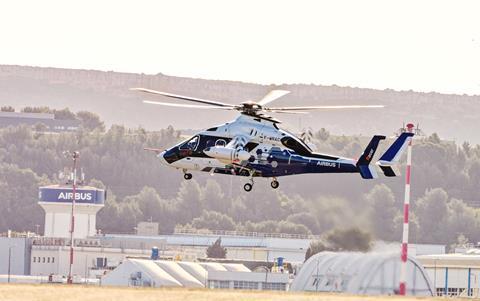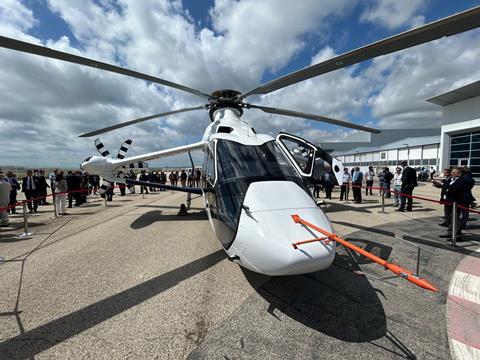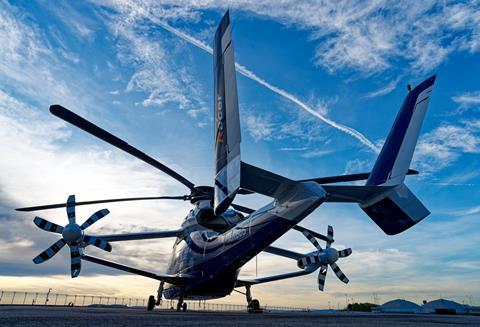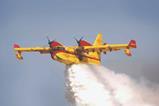Airbus Helicopters is rapidly opening the envelope of its Racer demonstrator, with the compound rotorcraft already having reached speeds slightly in excess of 165kt (305km/h) and performed a series of increasingly aggressive manoeuvres in the three test flights since its maiden sortie in late April.
And, while only preliminary estimates can be made from the data collected so far, programme executives are already confident that the Racer can comfortably beat its 20% fuel-burn reduction target.

Featuring V-shaped box-wings, twin vertical tails, asymmetric tail boom, twin pusher propellers and a five-bladed main rotor, plus a low-drag configuration, the Racer is targeting a cruise speed of 220kt. Launched in 2017, development of the demonstrator has been part-funded by the EU’s Clean Sky 2 programme.
Tomasz Krysinski, head of research and innovation at Airbus Helicopters, says the demonstrator has so far shown “excellent behaviour”.
On its 25 April first flight of 30min, the Racer reached 80kt, rising to 55min and 160kt on the second and 1h 40min and 165kt on the third.
The fourth sortie – performed as part of an event to showcase the aircraft at the airframer’s Marignane headquarters on 15 May – saw the helicopter fly for 1h 20 min and at a speed that was “about 10 knots more”, says Krysinski.
Test flights have also become increasingly dynamic, already including 2g turns and “very deep dives and climbs”, he adds.
In fact, says Brice Makinadjian, Racer chief engineer, the aircraft has achieved bank angles of “more than 45° at 150kt” and performed “autorotations at 80kt in descent”.
Readings from the 700 individual sensors installed on the Racer have not come “close to the limitations and even lower than what would be expected”, he adds.

Although stressing the envelope is being opened in a “progressive” and “humble” way, Krysinski also concedes it is happening quickly.
“To achieve all that by the fourth flight – I have never seen in my career to date it happen so quickly.”
Makinadjian also points to the reaction of the flight-test team: “The crew are very happy with the handling qualities of the aircraft.”
Chief test pilot Herve Jamayrac – who has been at the controls for every flight so far – says the Racer “looks beautiful and flies beautifully”.
Jamayrac was also a pilot on the X3 programme on which the Racer builds, and while there are obvious similarities between the two “the big difference is the maturity”, he says, adding: “We are at a maturity level that we reached after 20 flights or even more on the X3.”
It took until the ninth flight of the X3 before it hit 160kt, he notes, with its maximum speed eventually topping out at 255kt.
The goal for the Racer is to achieve a cruise speed of 220kt – a target it should reach later this year. “From the power left it is clear that it is going to fly way faster [than 160kt],” says Jamayrac.
Data displayed by the airframer during the fourth test flight showed that both of the Racer’s Safran Helicopter Engines Aneto-1X were at 50% torque with the aircraft at 160kt true air speed.

Before it can push for 220kt, however, the airframer must seek a modification from the French DGAC civil regulator for the Racer’s permit to fly, which currently places a limit of 165kt on the aircraft.
But the Racer is not only about speed – it must also demonstrate a level of frugality, delivering a fuel-burn reduction of 20% against current-generation helicopters of a similar size.
In that regard, the early signs are highly promising. “The first indications we have in terms of [fuel] consumption and performance are leading us to think that we will have a good surprise in the next few weeks,” says Makinadjian.
“During the development [low] drag was the main parameter in terms of decision making. It seems that has paid off – the first indications are that we have low drag, even a bit lower than predicted.”
Krysinski agrees, adding: “I think we will do even better – the first results show drag is really excellent.” The initial data shows the Racer using around 300kW less power than a conventional helicopter at 165kt, he says.
Further improvements are likely to come with the installation of a low-drag cowling for the main rotor head and landing-gear doors.
In addition, the first flights have been conducted without the flaps installed on the lower wing due to a last-minute alignment issue. These will be fitted in the coming days, says Makinadjian.

One aspect of the low-drag design, however, is a very narrow fuselage in comparison with traditional helicopters.
Krysinski says the airframer has taken its design cues from the long, thin fuselages of fixed-wing aircraft: “If you increase the length, L over D [lift over drag] improves. We can make it longer, no problem.”
More fuel-burn savings are anticipated from the so-called “eco-mode” function on the engines, which allows one to be shut down in cruise, while the other runs at an optimal power output.
Installation of this system will take place later this year or in early 2025, to allow flight tests next year.
Crucially, 2025 will also see the Racer perform a series of mission demonstrations as the airframer analyses the commercial potential of the design.
These include VIP transport – for example, a flight linking a city-pair – emergency medical services, search and rescue, including hoisting operations, and even those for the military.

“We are planning to propose some flights to military officials to demonstrate the capability of the Racer and the high-speed formula.
“But also, and this is what is most important, to gather their feedback about the aircraft and check if an adaption or a derivative of the Racer could be a good answer to their needs.”
Showcasing the compound architecture’s capability, alongside the technology maturation effort, will be vital to the launch of any future programme, says Bruno Even, Airbus Helicopters chief executive.
“It gives us the opportunity to be ready to launch a new programme”, should customers conclude they are willing to pay the price for speed, he says.
Due to the nature of the Clean Sky 2 funding, the Racer’s development involved 40 companies drawn from 13 different countries.
“A project of this scope could not come to fruition as a product of only one country or company,” adds Even, noting that it highlights the potential in Europe for “innovation, industrialisation and competitiveness”.































